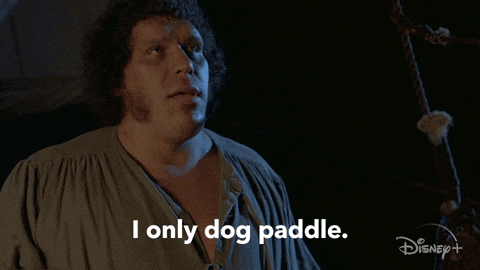I swear by this framework
Painfully simple, incredibly effective
I love a good framework.
How to lay out a product page on a website.
How to build out an ad campaign on LinkedIn.
How to structure a nurture email series in Hubspot.
But as I grew over my career + went from a specialist living in the tactics to orchestrating the bigger picture, I realized I didn’t have a good, simple framework for approaching the market holistically. Something that could keep me grounded and avoid doing “random acts of marketing”.
And that led me to the simple, 5-part framework I use today:
Sponsor: HockeyStack
I was in the executive conference room of a $750M+ company, presenting a marketing readout to the CEO, CFO, and 10+ leaders. As they sat around the conference table, I could tell all they wanted to ask was this: "So what?"
I was spewing data. "Look at how knowledgeable I am with all of this data!" And that was the day I learned a critical lesson:
😅 Data without context is meaningless. But more than that, data without a "so what?" insight is even worse. And right here is the question that dashboards don't answer. Dashboards are great at passively visualizing data, but not at *proactively* helping us to understand what we should do about the data...until now.
Hockeystack just closed this gap between data and insights/execution. They've built out the "so what?" straight into the platform so that marketers + GTM leaders don't make the same mistake I did early in my career. Odin analyzes all of the data, surfacing insights, and recommending actions + then have Nova launching plays acting off of it.
This is the kind of speed we need to be operating at as we move into the AI era. And for marketing leaders like me, never again will I have to worry about trying to sift through siloed data from all of our various marketing channels to form an insight and act on it.
Audience
Always start with the audience. Full stop.
All of the other cascading elements in this framework depend upon this to be successful. We could have a killer message that was written by Shakespeare himself, but if it’s not written to the right audience, it doesn’t matter.
Audience also does not mean the full total addressable market (TAM).
Drill down to your ICP
Drill down further to a segment within your ICP
Drill down even further to a segment within your ICP and their persona
The more specific I’m able to get with the audience, the more relevant all of the cascading elements will be.
Message
The audience informs the message.
The connection between audience + message is the biggest “relevance” lever we have to pull. The broader the audience, the more generic the message needs to be. The narrower the audience, the more relevant the message can be.
This is the best place to show the audience we really understand them. Their goals. Their pains. Their day-to-day tasks. What they feel.
While it’s easier to stay high-level and only write one message because it’s less time-intensive for us, the ability to take the core message I want to communicate + make it relevant to all of the various audiences is where revenue growth is found.
Timing
Now that we have our overarching messaging, we need to align it to the timing of where our market is at. One of the biggest mistakes I made early in my career was assuming all prospects were always in “active evaluation” mode, but the reality is that about 5% of the market is only ever actively searching for new solutions.
This means we need to break down the message to meet the market where they’re at.
For those not looking for anything new, it’ll look like an educational piece of content bringing awareness to a larger problem they may not even be thinking about + getting them to think more about if that’s something they’re experiencing.
For those who know they have an issue, but aren’t looking because they’re in a contract with a competitor for another year or don’t have the budget, it’ll look like a comprehensive guide or business case template that the prospect can use to start driving internal awareness + getting more internal buy-in.
For the 5% who are actively seeking a new solution or are already engaged with the sales team, it’s allowing them to get their specific information into the system and showing a preview of the benefit they’ll get (i.e. save time, save money, make more money).
Channel
Not until we know the above 3 items should we be thinking about channels.
I love to share content on LinkedIn for marketers + GTM practitioners because that’s where a number of marketers + GTM practitioners spend their time. If I created content for surgeons + medical practitioners, I probably wouldn’t be spending too much time on LinkedIn as 7 out of 10 medical professionals don’t even have a LinkedIn profile. Know where your audience spends their time + go there.
But to the cascading waterfall, as we think about channels, the message + timing heavily influence which channel(s) should be used. Cold-calling a prospect who’s never heard of you or shown any type of buying signal and trying to get them to convert on the spot is probably not the best message x timing x channel combo.
Calling an internal champion who’s been heavily engaged with us via email for weeks + building out a business case to present to their larger buying committee - well, that’s probably a much better message x timing x channel combo.
Every channel has its strengths and weaknesses for when to use them. And those strengths and weaknesses can typically be mapped to things like the audience they’re in, the type of message being communicated, and the stage (timing) the prospect/customer is at.
Medium
And finally we get to the medium. How are we actually delivering the message within a channel.
I was on a webinar panel this past week and Reddit was brought up as a channel. One of the panelists said they will never run ads on Reddit in fear of getting shredded by that audience (which is a very fair fear). BUT, I countered that if you’re getting shredded on Reddit, it’s often because something is being forced into there and not matching the communication style of the channel.
If you take the same ad you run on LinkedIn (a business professional social networking site) and run that on Reddit (an unhinged, anonymous community), it’s no surprise you’ll get shredded by them. But if you go back to the message you want to communicate and format it to an appropriate medium for Reddit (a meme, a self-deprecating video, etc.), it will land much better on the channel.
Rarely is the channel the actual problem - it’s the lack of awareness of how to use the right playbook on the channel that’s the problem.
Conclusion
I loved to overcomplicate things early in my career. I thought it made me appear smart to senior leaders since I could operate within so much complexity. But as my good friend Paul Stansik wrote about last year, in a world full of Simplifiers and Complicators, it’s far better to be a Simplifier.
This framework is probably one of the most simplified strategy docs I use. Whether I’m launching a brand new product, expanding into a new market, want to increase customer usage, or any other number of scenarios, this framework is applicable across the board.
One interesting insight in seeing it in a visual format like this is what the inverted form of this looks like. When we start with the medium, then push it to channels and upward from there, that’s the equation for random acts of marketing. And then we wonder why we don’t see meaningful, scalable results.
Book quote of the week
“The first mistake rarely proves disastrous, but the downward spiral of the second, third, and fourth error creates a devastating chain reaction.”
- The Art of Learning, by Josh Waitzkin
In case you missed these this week
See you next Saturday,
Sam










Yes! My favorite frameworks cascade just as you've shown. And marketing frameworks should often start with your buyer or audience and work forward from there. In violent agreement with you here.
"Random acts of marketing" - Imma pocket that one and give you credit whenever I deploy it.